Posted in Blog, Boost Your Brainpower, Entrepreneurship, Innovation by Jo North
Growth Mindset: Develop the Confidence to Succeed
A growth mindset is an essential ingredient when it comes to achieving your big, ambitious goals.
It can be exciting and inspiring to set intentional goals and create plans for how to achieve them. But sometimes we can get in our own way when it comes to making progress. Our own mindset and lack of self-belief can hold us back – often unnecessarily.
In this article I’m going to share some brilliant, science-backed tips – or Jedi mind-tricks 😊 – that you can use, starting right now, to strengthen your growth mindset and tackle your challenging, ambitious professional, career and business goals to innovate and succeed with confidence.
You’ll explore the importance of a growth mindset, and how a few strategic, minor adjustments can positively transform your decisions and actions to accelerate and strengthen your success.
Jump to…
- Goal confidence is Empowering
- Definition of a Growth Mindset
- Carol Dweck and the Discovery of the Growth Mindset Principle
- Beware the False Growth Mindset
- Real Life Success Stories
- Growth Mindset and Lean Innovation
- Growth Mindset and Self-Efficacy
- The Stories You Tell Yourself Influence Your Growth Mindset
- Growth Mindset – Confidence Building Tips
- Growth Mindset – Problem Solving Tips
- Growth Mindset Interventions for Business Professionals
- Next Steps for Developing Your Growth Mindset
Goal Confidence is Empowering
Having the confidence that you have, or will develop, the skills and resilience you need to achieve your goals is empowering.
Goal confidence:
- Motivates you to take action
- Drives innovation
- Helps you to overcome obstacles
- Drives your progress
- Supports your wellbeing, helping you to thrive as your grow
- Adds to the enjoyment of your journey towards to your goals, the process of working towards them
“It is good to have an end to journey toward; but it is the journey that matters, in the end.”
Hemingway
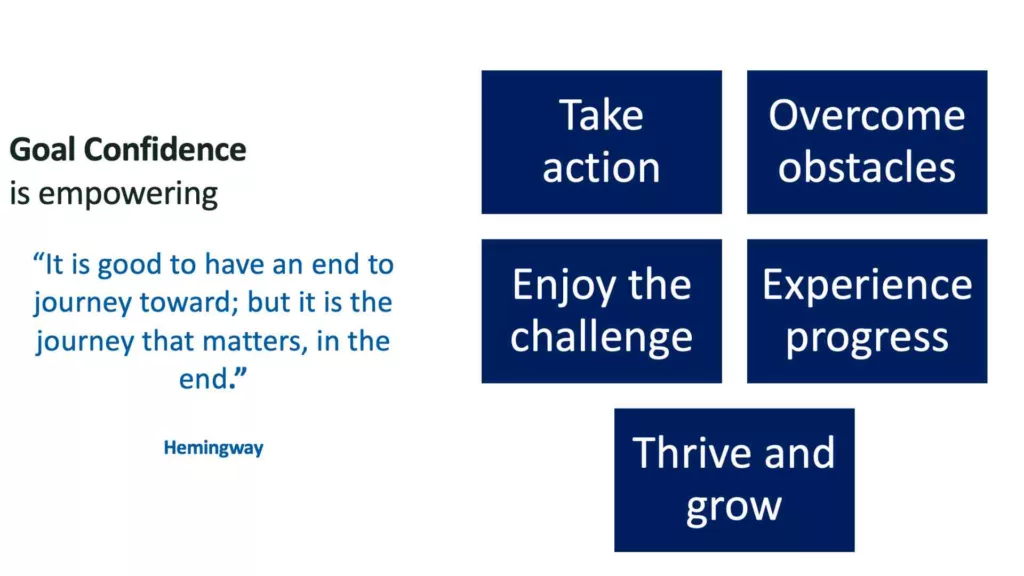
Definition of a Growth Mindset
Having a growth mindset means that you are willing to try new experiences and develop new skills. You know that you will not always get everything right, but that you’ll learn from your mistakes. You understand that your effort and attitude directly influence your abilities and success. Challenges are an opportunity to grow, and constructive feedback gives you insight that can help you improve. You know that when you fully apply yourself, you can achieve almost anything that you set your mind to.
Fixed Mindset vs Growth Mindset
The term ‘growth mindset’ is the opposite of ‘fixed mindset’. People who demonstrate a fixed mindset are afraid to fail and get things wrong. This is because they think failure reflects the limit of their abilities. They give up more easily, want to become experts more quickly and don’t enjoy the learning process. Also, individuals with a fixed mindset take feedback personally. They think it’s more important to be right than it is to learn.
We Have a Different Mindset at Different Times
Of course, in reality it’s unlikely that your mindset is always growth-focused or fixed. It varies according to the situation, how you’re feeling and other factors. That said, it’s interesting and helpful to notice your own mindset when you’re thinking about and working towards your goals. You can do this by observing what you tell yourself when things don’t go well, or when you get feedback.
The Remarkable Journey of Carol Dweck and the Discovery of the Growth Mindset Principle
The growth mindset principle, which has revolutionized the way we approach learning and personal development, was brought to life by the groundbreaking work of psychologist Carol Dweck. Here’s a quick summary of the fascinating journey of how Dweck discovered this transformative principle and the background to her research.
The Early Days: A Curious Mind
From a young age, Carol Dweck was captivated by the power of the human mind. Growing up in Brooklyn, New York, she was intrigued by the differences in how people coped with challenges and setbacks. This curiosity led her to study psychology at Barnard College, followed by a Ph.D. in social and developmental psychology at Yale University.
The Pivotal Question: Why Do People Respond Differently to Challenges?
Dweck’s research began to focus on the differences in how people responded to failure and to trying new things. She noticed that some individuals were more willing to get out of their comfort zone, and that they bounced back from adversity with renewed determination. Others, in contrast, appeared to be crushed by the experience. This observation spurred a critical question: what factors determined how people reacted to challenges?
The Breakthrough Moment: Fixed vs. Growth Mindset
Through years of research, Carol Dweck uncovered the answer to her question: the key to understanding people’s reactions to challenges was their mindset. She identified two distinct mindsets: a fixed mindset, in which individuals believe their abilities are static and unchangeable, and a growth mindset, where they believe their abilities can be developed through hard work and dedication.
Dweck’s research demonstrated that individuals with a growth mindset were more likely to persevere in the face of challenges, while those with a fixed mindset were more likely to give up or avoid challenges altogether. This discovery had profound implications not only for individuals but also for educators, parents, and leaders in various fields.
Collaboration with Kyla Haimovitz, Ph.D
Kyla Haimovitz, Ph.D., is a researcher and psychologist who has made significant contributions to the field of growth mindset, particularly in the context of parent-child relationships and their impact on children’s motivation, students’ mindsets, and academic achievement. Haimovitz collaborated with Carol Dweck on several research projects, focusing on understanding the influence of parents’ mindsets and their reactions to their children’s failures.
In their research, Haimovitz and Dweck found that parents who held a growth mindset tended to view their children’s failures as opportunities for learning and growth, rather than as indicators of their inherent abilities. These parents were more likely to respond constructively to their children’s setbacks, fostering an environment that encouraged the development of a growth mindset in their children, leading to positive results and higher grades.
Haimovitz’s work has helped expand the understanding of the growth mindset beyond the individual level, highlighting the important role that parents and caregivers play in shaping their children’s beliefs about their own abilities and potential for growth. Through her research with Carol Dweck, Kyla Haimovitz has deepened our comprehension of how growth mindset principles can be applied to parenting and family dynamics, ultimately promoting children’s motivation, resilience, and academic success.
Spreading the Word: The Impact of the Growth Mindset
In 2006, Carol Dweck published her influential book, “Mindset: The New Psychology of Success,” which brought the growth mindset principle to a wider audience. The book’s popularity propelled Dweck’s ideas into the mainstream, transforming the way millions of people around the world approached learning and personal development.
Today, the growth mindset is embraced by educators, parents, and organizations worldwide. Dweck’s work has inspired countless studies, programs, and initiatives aimed at fostering a growth mindset in individuals of all ages, empowering them to embrace challenges and view failure as a stepping stone to success.
Impact
Carol Dweck’s discovery of the growth mindset principle has had a profound impact on how we understand learning, personal development, and success. By uncovering the power of a growth mindset, Dr. Dweck of Stanford University has inspired a global movement to help individuals realize their full potential and transform their lives, by seeing growth as an important part of the learning process.
Impact on Primary and Secondary School Students
The growth mindset has proven to be particularly transformative for primary and secondary school students. At this crucial stage in their development, children are forming their identities and beliefs about their capabilities. By fostering a growth mindset in the classroom, educators can help students embrace challenges and view setbacks as opportunities for growth, rather than as indicators of their inherent abilities. This shift in mindset has been linked to improved academic performance, increased motivation, and enhanced resilience in the face of obstacles.
When students internalize the growth mindset, they become more willing to take risks, persevere through difficulties, and develop a lifelong love for learning. As they progress through their academic journey, these students develop critical problem-solving skills and a sense of self-efficacy, empowering them to believe in their ability to achieve their goals.
Impact on the World of Work
The benefits of a growth mindset are not limited to the classroom; they extend well into adulthood and the world of work. In an increasingly competitive and ever-evolving global economy, the ability to adapt, learn, and grow is paramount to professional success. Individuals with a growth mindset are more likely to embrace new challenges, seek out opportunities for growth, and remain resilient in the face of setbacks.
Business leaders have recognized the value of a growth mindset in the workplace, as it fosters a more innovative culture: one of creativity, collaboration, and continuous improvement. By cultivating a growth mindset culture, organizations can drive greater productivity, creativity, and engagement, ultimately leading to long-term success and new strategies in an ever-changing world.
Embracing the growth mindset, both as individuals and as a society, opens the door to limitless possibilities and unlocks the potential for growth in every aspect of our lives.
Beware the False Growth Mindset
A false growth mindset, also known as a pseudo-growth mindset, refers to a superficial or incomplete understanding of the growth mindset concept. It occurs when individuals or organizations claim to embrace the growth mindset but fail to embody its core principles, often due to common misconceptions or misinterpretations of the concept.
There are several ways in which a false growth mindset can show itself:
Praising effort without considering progress or outcomes
A key tenet of the growth mindset is valuing effort and persistence. However, a false growth mindset arises when people praise effort alone, regardless of whether it leads to progress or learning. In a true growth mindset, effort is essential, but it should be combined with the use of effective strategies and learning from setbacks to achieve meaningful growth.
Misunderstanding the role of innate talent
Another misconception that can lead to a false growth mindset is the belief that talent or ability is irrelevant. While a growth mindset emphasizes the importance of effort and learning, it doesn’t negate the existence of natural talent, genetic makeup, intellectual abilities or predispositions. Instead, it posits that everyone has the potential to grow and develop their abilities through hard work, effective strategies, and support from others.
Failing to address underlying beliefs or behaviors
Some individuals may claim to have a growth mindset, but their actions and behaviors still reflect a fixed mindset, and have a fear of failure. This inconsistency could stem from a lack of self-awareness or an incomplete understanding of what it truly means to adopt a growth mindset. To cultivate a genuine growth mindset, individuals need to recognize and address their fixed mindset beliefs and behaviors, and actively work to change them.
To develop a true growth mindset, it is crucial to have a comprehensive understanding of its core principles and consistently apply them in everyday life.
Real-Life Success Stories: Growth Mindset in Action Among Business Professionals
The power of a growth mindset transcends boundaries and has the potential to transform careers, drive innovation, and lead to exceptional achievements. Here are some real-life examples of diverse business professionals who have harnessed the power of a growth mindset to overcome challenges and achieve remarkable success.
Indra Nooyi, Former CEO of PepsiCo
Indra Nooyi’s journey from humble beginnings in India to becoming the CEO of PepsiCo exemplifies the power of a growth mindset. Throughout her career, Nooyi constantly adapted to change and sought opportunities to learn and improve. As CEO, she demonstrated a growth mindset by embracing innovation and sustainability, leading PepsiCo through a significant transformation and driving long-term success.
Satya Nadella, CEO of Microsoft
When Satya Nadella took the reins as Microsoft’s CEO, he brought a growth mindset culture to the organization, revitalizing it and driving innovation. Nadella emphasizes the importance of continuous learning and improvement, encouraging employees to experiment, take risks, and learn from setbacks. Under his leadership, Microsoft has seen a remarkable resurgence, becoming one of the world’s most valuable companies.
Oprah Winfrey, Media Mogul and Philanthropist
Oprah Winfrey’s inspiring journey from an impoverished childhood to becoming a self-made billionaire is a testament to the power of a growth mindset. Throughout her career, Winfrey faced numerous challenges, but her unwavering belief in her ability to learn, grow, and overcome obstacles propelled her to achieve unparalleled success in the media industry and beyond.
Lei Jun, Founder and CEO of Xiaomi
Lei Jun, the founder and CEO of Xiaomi, exemplifies a growth mindset in his approach to building one of the world’s leading technology companies. Despite facing intense competition and market challenges, Lei Jun has fostered a culture of innovation and continuous improvement at Xiaomi. This growth mindset has enabled the company to rapidly expand its product portfolio and global presence, achieving remarkable success in just over a decade.
How a Growth Mindset Culture and Lean Innovation Principles Drive Business Success
Innovation is the lifeblood of any thriving business, and fostering a growth mindset culture, combined with lean innovation principles, can be the perfect recipe for success. Here’s how a growth mindset culture and lean innovation work hand-in-hand to empower businesses to innovate successfully and stay ahead of the curve.
Growth Mindset: The Foundation of Innovation
A growth mindset culture lays the groundwork for a business to flourish by embracing the belief that skills and intelligence can be developed through effort, learning, and perseverance. This mindset encourages employees to take risks, learn from setbacks, and continuously improve – all crucial ingredients for innovation.
In a growth mindset culture, employees are empowered to challenge the status quo, experiment with new ideas, and iterate on existing processes. This mindset not only fuels creativity and problem-solving but also fosters collaboration and the sharing of knowledge across the organization. By creating a safe environment where employees can grow, learn, and take risks, businesses can unlock their full potential for innovation.
Lean Innovation: The Agile Approach to Success
The principles of lean innovation complement a growth mindset culture by emphasizing customer-centricity, rapid experimentation, and iterative development. Lean innovation encourages businesses to identify and test key assumptions through minimal viable products (MVPs), gather valuable feedback, and continuously refine their offerings based on real-world insights.
By combining a growth mindset with lean innovation, businesses can more effectively navigate the innovation process, reducing waste, and accelerating time to market. The iterative nature of lean innovation aligns seamlessly with the growth mindset’s focus on learning from setbacks and embracing continuous improvement.
The Winning Formula
When businesses cultivate a growth mindset culture and apply lean innovation principles, they create a powerful synergy that drives innovation success. Employees feel empowered to take risks and learn from failures, while the lean approach ensures that resources are utilized efficiently, and customer needs remain at the forefront of every decision.
This winning formula encourages businesses to stay agile and adapt to the ever-evolving market landscape, fostering a culture of continuous learning and improvement. By embracing the growth mindset and lean innovation principles, businesses can unlock their full potential for innovation, setting the stage for long-term success and a competitive edge in the marketplace through their innovation strategy.
Growth Mindset and Self-Efficacy
Nurturing your growth mindset will help to:
- Achieve major growth over time
- Become more resilient
- Build your grit and determination
- Enjoy the stretch
- Become more outcome-independent
A growth mindset is a key ingredient of a special type of self-confidence called self-efficacy.
Self-efficacy means that you know that you’ll figure it out and make it work. Even if you don’t know how yet.
It’s your confidence in your own ability to influence your own motivation, behavior, and social environment to make things happen.
Self-efficacy helps you to focus on growing or sourcing the skills and knowledge you need to achieve your goals.
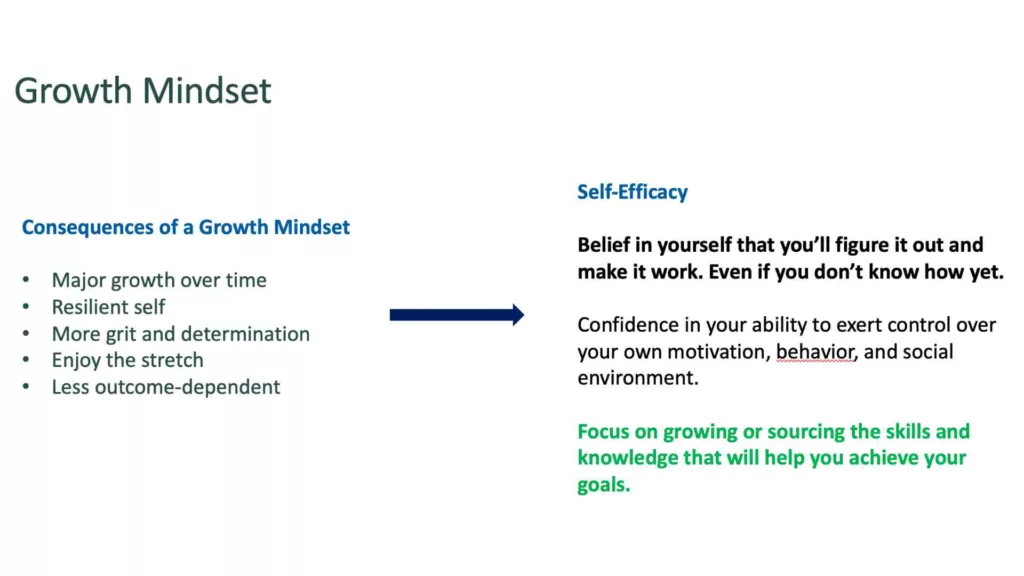
The Stories You Tell Yourself Influence Your Growth Mindset
The stories your mind presents as facts aren’t always true.
Worse, these stories turn into false beliefs about others, the world, and yourself. They keep you from your true potential by creating limiting beliefs.
Your Inner Critic
Our inner critic starts to develop when we begin to hear the word ‘no’
As children, we hear the disappointment, worry, or anger in grown ups’ voices as we are about to do something we shouldn’t.
This continues to build as we grow, because we are exposed to it for longer.
Remember – your inner critic is trying to take care of you, but that doesn’t mean it’s right!
Perfectionism
Perfectionism isn’t a strength, it’s usually a weakness.
Studies show that perfectionism can make us unwell. It contributes to anxiety, depression, poor sleep, low self-esteem, and a negative impact on our resilience.
Comparing who we are and how well we’re doing against a benchmark of perfection gives power and ammo to our inner critic. Instead of seeking to achieve perfection, seek to achieve excellence instead. It’s both realistic and better for us all round.
Control is an illusion. Trying to control people, how things are done and outcomes is an impossible task. It’s wiser to appreciate that we can only influence up to a point, and instead become more flexible:
… serenity to accept the things I cannot change, courage to change the things I can, and the wisdom to know the difference, living one day at a time; enjoying one moment at a time; taking this world as it is and not as I would have it.
Serenity Prayer
Growth Mindset – Confidence Building Tips
It’s unrealistic to expect to have a growth mindset all the time. Sometimes our confidence can take a knock, which could temporarily disrupt your growth mindset. So, here are some tips to help you with those times when your confidence may dip:
Posture and breathing
Stand tall and breathe deeply to instantly boost your confidence and clarity.
Focus on problem-solving and learning
Embrace the journey of discovery, and let go of the need for immediate answers.
Ask questions
When in doubt, ask questions to uncover insights and demonstrate your curiosity.
Remind yourself of past successes
Reflect on your achievements to reignite your self-belief and motivation.
Modeling
Draw inspiration from others’ success, using their journey as a roadmap for your own growth.
Challenge and mastery experiences
Step out of your comfort zone and embrace challenges to build competence and confidence.
Positive self-talk
Acknowledge your progress and strengths to reinforce a positive self-image.
Support and encouragement
Lean on your support network to uplift and motivate you during tough times.
Disrupt rumination
Break free from negative thought patterns by engaging in activities that keep your mind busy with other things, or that bring you joy and relaxation.
Growth Mindset – Problem-Solving Tips
There are times when we are working towards our goals and it feels like we have hit a brick wall. We can’t see a way forward, and it can seem that the only option is to give up or postpone our efforts indefinitely. Work through these insightful tips to help you gain traction and maintain momentum. You’ll also find my article here on how to stay motivated to achieve your goals super-helpful, too.
1. Identify the Real Problem
When you’re feeling stuck like this, the first step is to identify the real problem. Sometimes the problem we perceive is not the real, actual problem.
We cannot solve our problems with the same thinking we used when we created them.
Albert Einstein
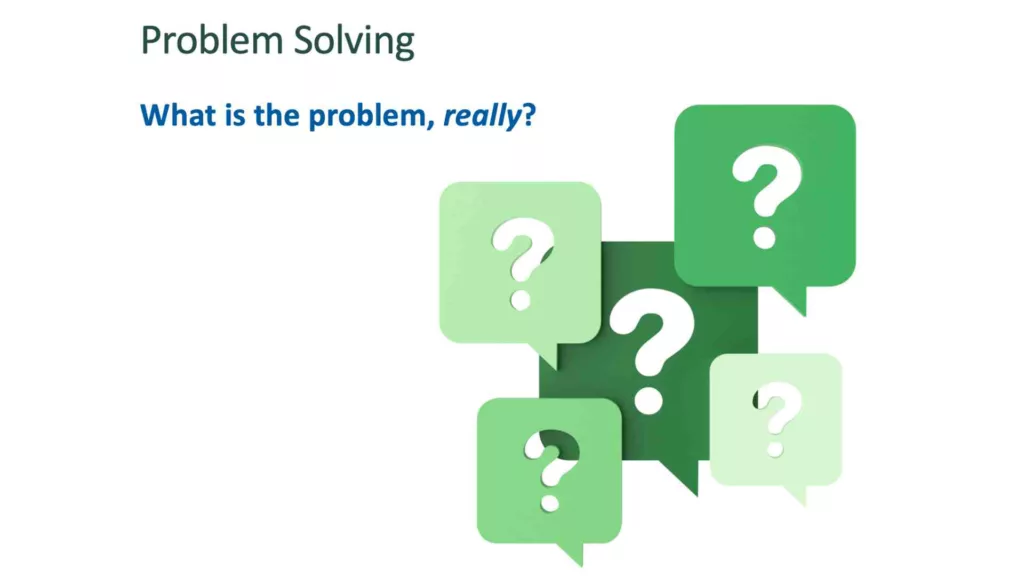
2. Journey Through The Fog of Uncertainty
You’ve done your intentional goal setting, and mapped out your plan to achieve your goals. You get started, and make some great progress. Then, as you go along, you realize that this isn’t going to be as straightforward as you first thought.
The goal posts might have moved. You might need to deal with fresh issues, that weren’t there at the start.
You may have uncovered new, very relevant information that sheds a whole new light on things. When you began, you didn’t know what you didn’t know.
In innovation terms, this is known as entering the “fog of uncertainty”.
…no linear process will help you when things feel uncertain, unknown, unfamiliar and terrifying. We call this the fog of uncertainty. It is the feeling you get when surrounded by conflicting, movable and unplannable elements.
Enter the fog with faith, trust and agility.
The vision doesn’t change, but how you get there might.
Design Council

Impact of The Fog of Uncertainty
The fog of uncertainty is the reason that many people quit too early, thinking that pursuing their goal wasn’t such a good idea after all. But it’s actually a natural and important part of the process. Think about it. You’ve set yourself some challenging goals that will achieve things you’ve never done before. There are bound to be times of uncertainty, when you’re not sure what to do.
Work through The Fog
The way through the fog is forward. With your headlights on, moving slowly. Nudging forward within the visibility range that you have. Work with what you can see and what you do know. Experiment and run mini-tests to explore what you don’t. Keep going and clarity will emerge. You’ll get back on course, using the data and insights you’ll get from the actions you’ve taken.
Sitting and waiting for the fog to lift for a short while is ok, as long as you get back into it soon – whether or not the fog has lifted. Pausing can bring clarity and perspective. If pausing doesn’t bring clarity it’s because you need more data. The only way you’ll get that data is through action, or by working to identify different perspectives and solutions with a coach or mentor.
3. Develop Your Lateral Thinking Skills
Instead of solving problems in the traditional way, through logic and analysis, lateral thinking uses indirect and creative approaches to come up with solutions that aren’t immediately obvious.
‘Vertical thinking is concerned with digging the same hole deeper. Lateral thinking is concerned with digging the hole somewhere else.’
Edward de Bono
In his groundbreaking work, Information Processing and New Ideas – Lateral and Vertical Thinking, psychologist Edward de Bono introduces four strategies to enhance our lateral thinking skills, which are crucial for developing innovative solutions for goal achievement.
1. Mindful Awareness
Before tackling a new challenge, acknowledge your brain’s tendency to fall back on tried-and-tested thought patterns. Consciously breaking free from these habits will pave the way for novel problem-solving approaches.
2. Creative Disruption
Avoid fixating on a single issue. Engage in diverse activities and entertain a wide range of possibilities. This approach will disrupt your usual thinking patterns, sparking innovative ideas that can help you find unconventional solutions.
For example, if your business is struggling with low employee engagement, consider exploring various team-building activities, flexible work arrangements, or even employee recognition programs to increase motivation and productivity.
3. Embrace Alternatives
When faced with limited options, strive to identify and explore additional alternatives. Even if an idea seems outlandish at first, don’t dismiss it outright. By modifying or scaling back these ideas, you might discover groundbreaking strategies that could propel your business forward.
Imagine you’re launching a new product, and conventional marketing channels aren’t yielding the desired results. Instead of sticking to the tried-and-true methods, consider using guerilla marketing techniques, influencer partnerships, or experiential events to create buzz and drive sales.
4. Adapt and Transform
Be open to altering your initial approach or perspective. This flexibility can lead to the discovery of fresh solutions and unexpected breakthroughs, ultimately empowering your business to overcome challenges and achieve its goals.
4. Break A Big Problem Down Into Lots of Tiny Problems
Descartes‘ method of breaking complex issues into smaller, manageable parts has stood the test of time and continues to be a powerful tool for tackling business challenges that stand between you and your goals.
The method is based on the principle of simplifying big problems by dividing them into smaller, more solvable components. By addressing each part independently, you can gradually work your way through the entire problem, eventually arriving at an effective solution.
The brilliance of this method lies in its ability to make seemingly insurmountable problems feel manageable and achievable.
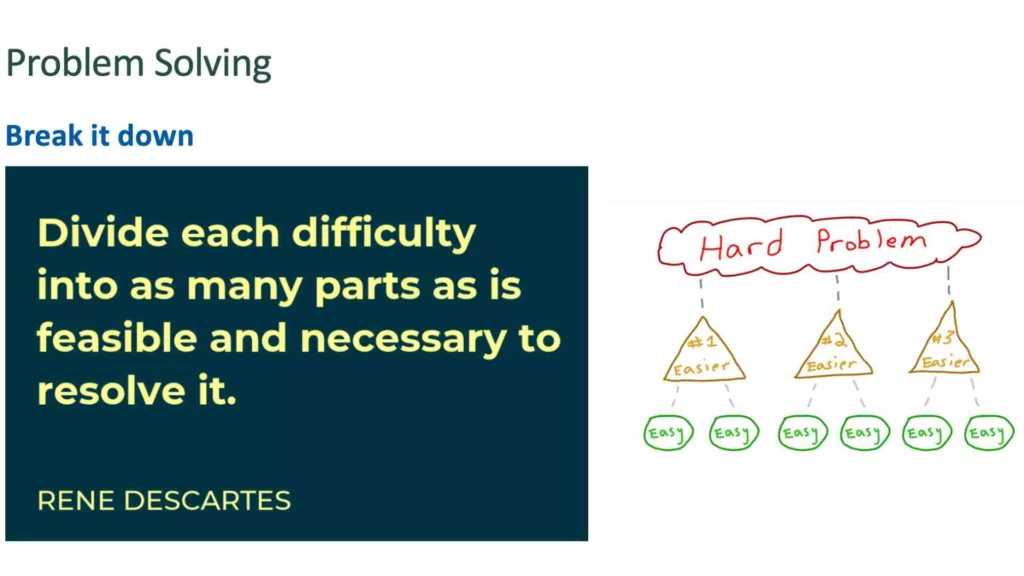
Here’s how you can use Descartes’ method to problem-solve your way to achieving your goals, using a step-by-step approach:
1. Identify the problem
As your starting point, clearly define the challenge you are facing. For instance, let’s say your company is struggling to achieve its goal of increasing its market share.
2. Break down the problem
Next, divide the larger issue into smaller, more specific sub-problems. In the market share example, you might break it down into areas such as product innovation, marketing strategies, competitive analysis, and customer engagement.
3. Analyze each component
For each sub-problem, gather relevant information and analyze the contributing factors. For instance, examine your product offerings and determine if they meet your customers’ needs, or analyze your marketing campaigns to see if they effectively target your desired audience.
4. Develop targeted solutions
Based on your analysis, create tailored solutions for each sub-problem. For example, you might decide to develop a new product line, revamp your marketing strategy, or invest in a better understanding of your competitors’ strengths and weaknesses.
5. Implement and monitor
Put your targeted solutions into action, and monitor their progress to ensure they’re effective in addressing the sub-problems. Adjust your approach as needed based on the results.
6. Tackle the next sub-problem
Once you’ve found a solution for one sub-problem, move on to the next, applying the same methodology. Repeat this process until you’ve addressed all the components of the larger problem.
7. Evaluate overall progress
With all sub-problems addressed, assess the impact of your combined efforts on the original problem. In our market share example, evaluate if your company has successfully increased its share in the market as a result of the targeted solutions implemented.
5. Your Brain and Growth Mindset
The power of belief and the role our emotions play in achieving our goals cannot be underestimated. In fact, our mindset – whether we believe we can or can’t succeed – often becomes a self-fulfilling prophecy. When we forge a deep emotional connection to a goal, our commitment to its achievement skyrockets.
Two critical parts of our brain work in tandem to drive our success in reaching our objectives. Understanding how this happens can help you to strengthen your growth mindset and build your goal confidence.
How the Amygdala and Frontal Lobe Join Forces to Help You Achieve Your Goals
The amygdala, the emotional powerhouse: This region of the brain evaluates the significance of a goal and gauges how deeply it resonates with us. It determines the level of our emotional investment and the importance we place on the objective.
The frontal lobe, the problem-solver: This part of the brain kicks into gear to figure out the steps we need to take to reach our goal. It devises the necessary strategies and plans for success.
Once the amygdala and frontal lobe join forces, they collaborate to fine-tune the skills and behaviors required to achieve the goal, while suppressing those that could be detrimental to our progress.
Brain Plasticity and Growth Mindset
Brain plasticity, or the brain’s remarkable ability to adapt and change, offers an exciting opportunity for business professionals seeking to develop a growth mindset. By understanding that the brain is constantly evolving and rewiring itself, you can take control of your own cognitive development and intentionally nurture a growth mindset.
Embrace challenges, seek out new experiences, and engage in diverse learning opportunities to stimulate your brain’s capacity for growth. As you do so, you’ll forge new neural connections, strengthening the growth mindset pathways in your brain.
This ongoing process of neural rewiring will empower you to face obstacles with resilience, adapt to change, and continually evolve in your career.
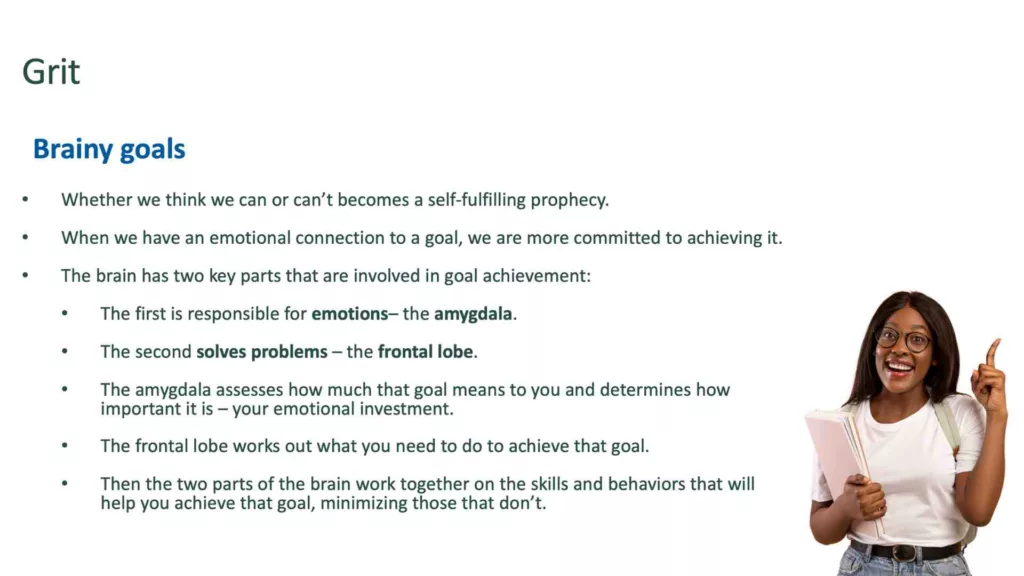
6. Visualization for Growth Mindset and Goal Achievement
Keeping your emotional investment alive and thriving is essential for achieving your goals, and one powerful way to do so is through visualization, also known as strategic mental rehearsal.
During visualization, your brain prompts your neurons to behave as if the imagined scenario is actually happening, leading them to perform specific actions. Remarkably, this mental exercise causes physical changes within your brain, forging new neural pathways.
These newly formed neural pathways prepare you to act in a consistent, repeatable manner that aligns with the goal you’ve visualized. By regularly engaging in visualization, you can strengthen your emotional connection to your objectives and prime your brain for success, ultimately enhancing your ability to turn your ambitions into reality.
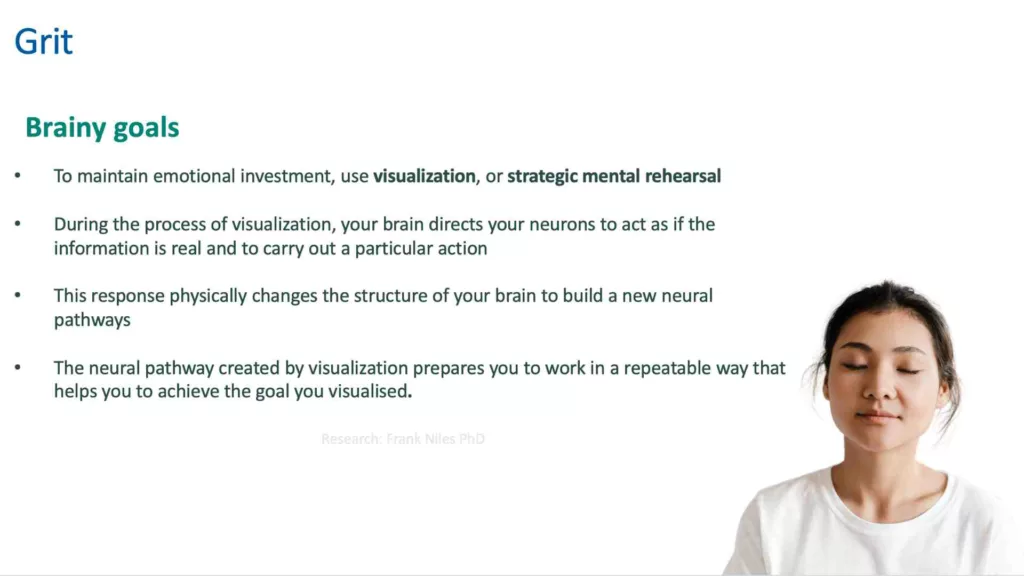
7. Use Grit
Research by Angela Duckworth and others shows that the people who succeed aren’t special super-humans. The one thing they share is something that we can all develop: grit. Grit means that you keep going – even when it’s hard work, and when you feel like giving up. It comprises perseverance and resilience, combined with passion. You can test yourself on Angela Duckworth’s grit scale quiz here and watch her Ted talk below.
Unlock Your Potential: Growth Mindset Interventions for Business Professionals
In today’s fast-paced business world, embracing a growth mindset is essential for your personal and professional development. As a business professional, adopting a growth mindset can help you overcome challenges, embrace change, and achieve your goals. A ground mindset intervention from the suggestions below might help you to accelerate your success:
Embrace Negative Feedback
Embracing a growth mindset can empower business professionals to transform negative feedback into a catalyst for success. Instead of the common misconception that criticism is an attack on your abilities or self-worth, approach it with curiosity and an open mind, seeing it as an invaluable opportunity to learn and grow.
When faced with negative feedback, remind yourself that setbacks and challenges are an integral part of the journey towards mastery. Use the feedback to identify areas for improvement, develop new strategies, and refine your skills.
By actively seeking lessons in every piece of feedback, you’ll foster resilience, enhance your performance, and set yourself on a path to excel in your career. This simple tweak can make a significant difference, in a meaningful way, to your growth mindset.
Leverage the Success of Others
A growth mindset can help business professionals turn the success of others into a source of inspiration and motivation, rather than a trigger for envy or discouragement. Embrace the achievements of your peers and competitors as opportunities to learn, grow, and refine your own approach.
By adopting a curious and open-minded perspective, you can analyze the strategies and habits that led to their success, and implement these insights into your own professional journey. Celebrate the accomplishments of others and actively seek collaboration, knowing that the sharing of knowledge and expertise can propel everyone towards greater heights.
With a growth mindset, the success of others becomes a catalyst for your own growth, fostering a positive and collaborative business environment where everyone thrives.
Growth Mindset Workshops and Seminars
Participate in interactive workshops or seminars focusing on growth mindset principles tailored for the business world. These sessions can help you identify fixed mindset beliefs, learn strategies to cultivate a growth mindset, and understand the impact of mindset on team dynamics, innovation, and leadership.
One-on-One Coaching and Mentoring
Invest in personalized coaching or mentoring to receive tailored guidance on developing a growth mindset in your professional life. A dedicated coach or mentor can help you recognize fixed mindset tendencies, set actionable goals, and provide ongoing support to ensure you stay on track.
Company-Wide Growth Mindset Training
Encourage your organization to adopt growth mindset training for all employees. This can help create a culture of continuous learning, resilience, and innovation throughout the company. By fostering a growth mindset at all levels, employees will be better equipped to face challenges, adapt to change, and contribute to the organization’s success.
Online Courses and Webinars
Enroll in online courses or webinars specifically designed for business professionals looking to cultivate a growth mindset. These digital resources often provide flexible learning options, allowing you to engage with the content at your own pace and apply the principles to your work in real-time.
Networking and Peer Support Groups
Join networking groups or peer support circles focused on growth mindset development. Connecting with like-minded professionals can provide valuable insights, encouragement, and accountability – especially when you’re facing more difficult situations. Sharing experiences and challenges with others can help reinforce your growth mindset and lead to collective growth and success.
Reflective Journaling and Goal Tracking
Regularly document your thoughts, experiences, and progress in a reflective journal or digital tracking tool. This practice can help you monitor your growth mindset journey, identify patterns or obstacles, and celebrate achievements. By maintaining a record of your development, you can gain insights into your mindset and make necessary adjustments to stay on track.
Mindfulness and Meditation Practices
Incorporate mindfulness and meditation practices into your daily routine to foster self-awareness and emotional regulation. These techniques can help you become more attuned to your thoughts and beliefs, enabling you to recognize and challenge fixed mindset tendencies as they arise.
Next Steps for Developing Your Growth Mindset to Achieve Your Goals
By integrating these growth mindset interventions into your professional life, you can unlock your full potential and reach new heights in your career. Embrace the power of a growth mindset and witness the transformative impact it can have on your personal development, professional success, and overall well-being. Remember, the journey towards it is an ongoing process – but with perseverance and the right strategies, the sky’s the limit!
Are You Ready?
Ready to supercharge your growth mindset journey and achieve your business goals? The Big Bang Partnership is here to help! Our team of experts specializes in delivering tailored growth mindset interventions and innovative business solutions to unlock your potential and drive success. Don’t wait – contact us today to explore our services and discover how we can empower you and your business to reach new heights.
Summary
In the realm of modern psychology, growth mindset has emerged as a key factor in fostering a positive attitude and driving success for business professionals. By challenging the belief that the amount of intelligence we possess is fixed, growth mindset introduces the idea that we can continually develop our skills and abilities through effort and perseverance. This transformative approach encompasses two types of mindsets: fixed and growth. By understanding and embracing the best way to apply the principles of growth mindset work, professionals can unlock their full potential, adapt to the ever-evolving business landscape, and excel in their careers. Ultimately, growth mindset has become an indispensable tool in modern psychology for cultivating resilience, motivation, and long-term success.

